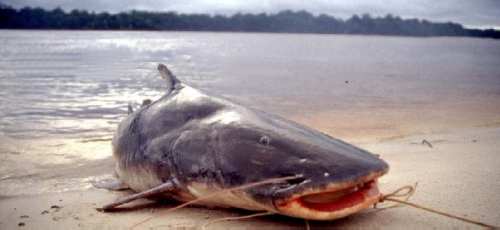Put the rubbish in the place..!!
hmm,what the meaning is that.??
for the some people maybe that just a ordinary logo in the wall, but if we want to think little deep about it, maybe we will not underestimate about that.
Graeme MacRae
 |
Temple and trash David Kuper |
Indonesia, like many developing countries, is drowning in rubbish. Per capita production of garbage is not high by world standards, but it is growing fast. The population is already large and it is increasing rapidly – and waste management practices lag far behind waste production.
Nobody knows the precise figures, but perhaps half of the country’s rubbish gets collected and of that, maybe half ends up getting incinerated or dumped in landfills. Most of the rest gets illegally dumped on vacant land or into rivers or beaches. Only a small proportion gets recycled. Incineration is inefficient and highly polluting. Landfills are breeding grounds for rats and flies, produce the foul-smelling, explosive greenhouse gas methane and leach pollutants into farmland and watercourses.Many people are trying to fix the problem. NGOs and local governments have introduced projects all over the country, trying to improve every stage of waste management from collection and transport to final disposal. But while a few such projects are successful, the scale of the problem is enormous.
Among all this mess the island of Bali appears a relative haven of ricefields, forests, rivers, beaches and tourist resorts. In reality, Bali’s ricefields and forests are rapidly being converted to urban uses, its rivers and beaches are being polluted with waste of all kinds and behind the lush greenery and sparkling facades of the up-market resorts are some less-than-ideal environmental practices.
Rapid economic development driven by tourism is the primary cause of these problems. Not only do tourists buy lots of consumer goods, many of them highly packaged, but the expansion of the industry is nurturing the growth of a new middle class with international-style consumption tastes and habits. But tourism is also part of the solution, because it has heightened awareness of the polluting potential of waste and stimulated search for solutions. So Bali can be seen as a kind of small-scale laboratory for the future of waste management in Indonesia.
This is the story of three projects which offer alternative approaches to dealing with rubbish. The first might be described as a boutique solution for high-quality hotel wastes, the second is an internationally funded high-tech mega-project and the third is a district level multi-party project that is now funded largely by carbon credits. The first option has been successful, but only because of the unusually rich waste stream it receives. The second has been plagued by problems. The third is the most promising, especially as a model for replication elsewhere, but ironically it is dependent on international funding through the carbon economy.
Five star waste
Yayasan Wisnu is a local NGO that was founded in 1993 to deal with waste problems in the popular tourist resort of Ubud. Its attempt failed for various reasons, leading the NGO to shift its attention to the tourism areas on the coast. Here, large hotels were creating large amounts of waste, most of which was being illegally dumped, although food waste was being sold to local pig farmers, one of whom had built a small business collecting and delivering it. Yayasan Wisnu managed to persuade the hotels that it was in their interest to take more responsibility for their waste. Out of this three-way collaboration, a new business was formed. Called Jimbaran Lestari, it is owned by the trucking contractor who had previously been collecting hotel food waste and receives technical and management support from Yayasan Wisnu.
Jimbaran Lestari began in 1996 with three hotels but now works with more than fifteen. The hotels pay for their waste to be collected in three separate collections: wet, dry and organic. It is trucked to a large, clean, well organised shed. The dry waste, mostly packaging, is sorted manually by labourers, most of whom are Javanese who are employed by the middlemen who buy the recyclables and then bundled and shipped to Java for recycling. The wet (mostly food) waste is drained and the solids are sold to pig farmers. Liquids are processed in a septic tank. Garden wastes are dumped in a yard behind the Jimbaran Lestari plant. Solid wood is separated and sold as firewood. Lighter materials are composted in big piles, sprayed regularly and turned manually. The resulting compost is then sold back to the hotels. Only the residual unrecyclable material – about 30 per cent of the total – goes to a landfill.
Jimbaran Lestari has been a relatively successful solution in both technical and economic terms. But its success is at least partly the result of some less-than-typical conditions, including its location at the centre of a number of major hotels and its early start in the business. Perhaps the most important keys to its success are the willingness of its customers to pay for collection and a waste stream much richer in recyclable materials than the average in Indonesia. So while it is a successful model, its success may not be easy to replicate in other situations.
Big solutions, big problems
Jimbaran Lestari is a small island in a sea of waste produced by the capital city Denpasar and surrounding semi-urban, light industrial and tourism zones. Most of the waste collected from this area is dumped in a huge landfill on coastal land reclaimed from a mangrove swamp at a place known as Suwung. A small army of scavengers collect metals, glass, plastics and paper for sale to recycling plants in Java. The remainder rots and festers in the tropical heat, attracting rats and flies, releasing large amounts of methane, and probably leaching contaminants into the sea.
In 2003 the governments of Denpasar and three adjacent districts (under the acronym Sarbagita) developed an ‘integrated’ plan for waste management for the whole of central-south Bali. They obtained funding to construct a plant at the landfill to process all the waste from all four districts for the next twenty years. The concept was to convert waste (of which there is too much) into energy (of which there is not enough).
The basic idea is not new, but its latest incarnation is conversion of landfill gases to electricity. Sarbagita sought design ideas and tenders for a public-private partnership from international energy companies and contractors. The model they ended up adopting involves burning both methane and dry material to drive turbines to generate electricity. It was hoped that this approach would produce initially enough electricity to power the plant itself, expanding to deliver electricity to around 700 local households.
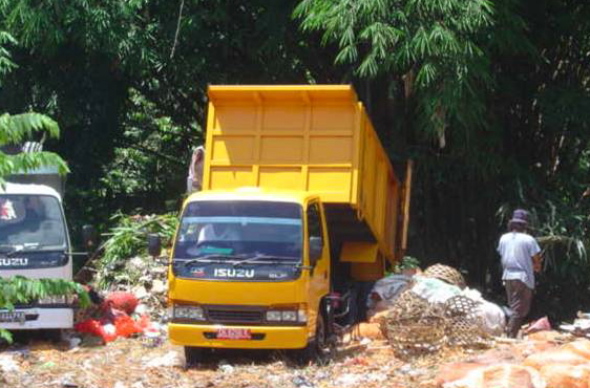 |
Legal trucks, illegal dumping |
The economic viability of the project relies also on obtaining carbon-credit funding through the Clean Development Mechanism (CDM), an international financial mechanism aiming to enable emission-reducing projects in poor countries to sell their carbon credits to net emitters in developed countries. The CDM is based on the belief that it is cheaper to reduce greenhouse gas emissions in less developed countries than more developed ones, which seems logical. But in this case, it hasn’t worked.
Three years on, gasification, digestion and electricity production are yet to begin. There have been problems with Sarbatiga’s CDM application, and also technical and environmental problems in both the site and the technology. Critics of the project claim that its sheer scale is neither efficient nor environmentally safe, involves high transport costs, takes any profits offshore and undermines the kind of local community-based approaches they believe are more appropriate.
A middle-range solution
Sarbagita at the large-scale end of the spectrum has serious problems and Jimbaran Lestari toward the lower end, has its limitations. The most successful projects to date is somewhere in between. It is closer to Jimbaran Lestari in size, but like Sarbagita, it attempts to process the entire waste-stream of one district of Bali. This is the Temesi Facility in the district of Gianyar.
This story begins with the waste problem in Ubud, which Yayasan Wisnu tried but failed to solve in the 1990s. This problem never went away, and in 2004 a new group, including the local Rotary Club and Bali Fokus, a new NGO spawned out of Yayasan Wisnu, tried again. They worked with a successful tourism entrepreneur in Ubud who had a network of political connections throughout the district.
The businessman hails from a village called Temesi, where the main landfill dump for the district of Gianyar (in which Ubud is located) happens to be situated. He persuaded the Temesi community and the district government to agree to a pilot project to recycle part of the waste stream at the existing landfill and arranged for all the necessary consents to be processed in a matter of days, rather than the usual weeks or months. Rotary already had funding sufficient for a facility to handle about four tonnes of waste per day.
The Temesi facility was constructed very rapidly and opened in mid-2004. It consists of a large open area with access for waste at one end and egress for finished products at the other. Inside, the rubbish is sorted manually by workers from the local village. They separate out the recyclable materials and package them for sale.
Despite minor technical and socio-cultural problems, the system worked well from the time it began. But it was limited by two critical factors. Firstly, it was processing only a small fraction of the existing waste stream, or only about four out of the 50 tonnes of waste produced every day. It needed to process much more to achieve the economies of scale necessary to pay for itself. Secondly, it soon became clear that less than ten per cent of the waste stream was actually recyclable, while more than 80 per cent was organic material, as is typical for non-urban areas in Indonesia. The solution was to enlarge the facility and shift the focus from recycling to production of compost for hotel gardens, public parks and private landscaping. The facility’s managers had already begun research and development to improve the quality of their compost. The site and waste stream were available, but to expand the facility, they needed more money.
Carbon credits to the rescue?
Around this point carbon-credit funding began to play a part in the story. A chance meeting provided a contact to a Swiss travel agency interested in providing funding through the CDM. The project qualified because it reduces emissions by taking organic material out of the waste stream entering the landfill, where it would otherwise decompose anaerobically (without oxygen) producing methane. By composting it aerobically (with oxygen) instead, it produces only carbon dioxide (CO2), a much less powerful greenhouse gas, leading to a net reduction of emissions.
So the project was reconceptualised and repackaged in terms of climate change in order to sell its emission reductions on the carbon markets. The facility managers also transformed the site from a typically malodorous tropical landfill dump into a landscaped ‘Climate Change Theme Park’ for visitors, especially school groups.
To obtain CDM funding any project needs to quantify and certify its reductions, make an application to the United Nations Framework Convention on Climate Change, obtain approval from the appropriate government agencies in both host and sponsoring countries and find businesses to buy its reductions. These are complex processes requiring sophisticated scientific, technical and legal skills which simply do not exist in villages like Temesi, despite the fact that the CDM framework was ostensibly designed for just such poor country sites. To meet these complex challenges, the Temesi facility managers had to hire specialist consultants in Europe to do most of this work, paid for with donor funding.
In 2008 the facility was certified for $1.5m worth of carbon credits over the following ten years. Appropriately, Kuoni, a large Swiss travel agency stepped forward to buy the credits. The agency wanted to offset the emissions caused by all the plane flights it booked, many of them to Bali.
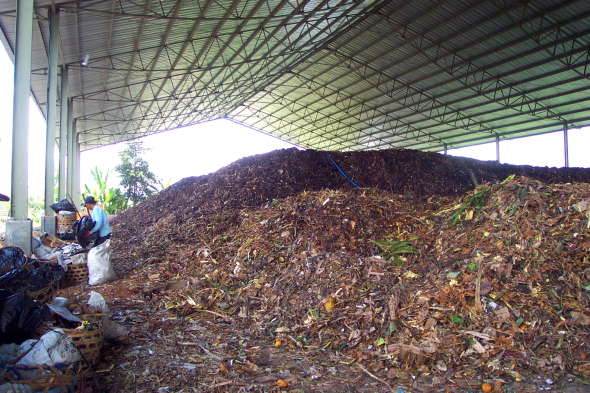 |
Compost Mountain, Temesi |
This funding was, however, contingent on maintaining the predicted level of production and to achieve this, Temesi facility still needed to expand its operations and find sufficient labour for the critical process of manual sorting. Local people are reluctant to work with rubbish for religious reasons. An alternative plan to bring dozens of experienced Javanese scavengers onto the site was complicated and delayed by local concerns about the influx of Muslim outsiders into the community. All these problems were eventually solved and the facility is now processing an average of 55 tonnes of garbage per day.
While this project still falls short of being an economically sustainable operation, it has achieved an extraordinary amount in a short period and represents an alternative model somewhere between the industrial-scale and community-based approaches, combining some of the benefits of both. It also represents, and was always intended, as a model that can be replicated at district level anywhere in Indonesia.
The present and the future
Rubbish is still growing in Indonesia. But so too are public awareness and attempts to deal with the challenge. The projects described above vary in scale and success. There are also even smaller scale community-level projects. But none of them presents a clear one-size-fits-all solution.
Converting waste into energy makes sense to everybody, but so far nobody has been able to make it work, except at very small scales. Recycling is at best a partial solution. The case of Jimbaran Lestari shows that with a sufficiently resource-rich waste stream and customers willing and able to pay for collection, recycling can be economically sustainable. But such cases are rare in Bali and even rarer in the rest of Indonesia.
Composting has wider potential because of the typically high organic content in Indonesian waste streams. The Temesi project demonstrates that compost-based solutions can work in situations typical of Indonesia, but it has depended on a complex mix of private, government, community and international participation and support. It has been a relatively slow and complex project to get off the ground, but it brings together and integrates a wide range of parties with a common interest in improving waste management. It was also designed specifically for replication at the level of the district, which is the most realistic and practical administrative and geographical unit for waste management.
The Temesi facility also shows the potential for funding of waste projects through the emerging global carbon economy. While the CDM has been widely criticised as a scheme for outsourcing of the emissions of developed countries to developing ones, and also for alleged fraudulent projects and accounting, in this case it has tipped the funding balance to enable a soundly based and innovative project to proceed. It has also channelled significant amounts of money from an affluent part of the world to a much less affluent community.
However, none of these projects has the capacity to keep up with the rate of production of waste. Any successful long-term solution will need to include reduction of waste. If this is true in the relatively well-managed environment of Bali, it will be even more so in most other parts of Indonesia

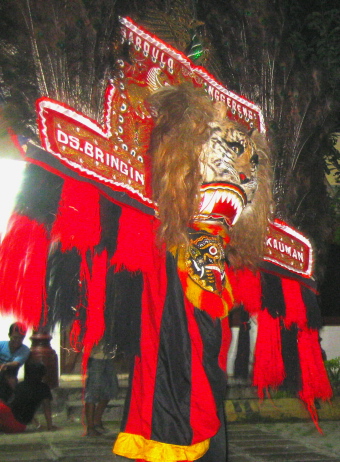
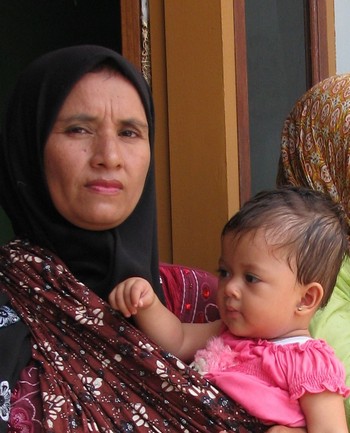
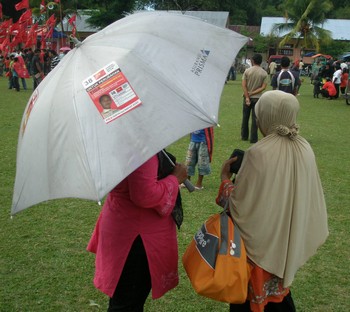













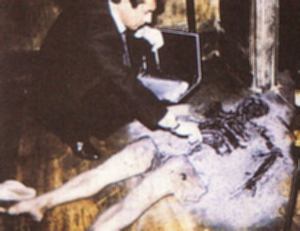








 Kalo kalian melihat sisa sisa bangunan yang ada di tempat wisata ini, kalian akan menemui banyak keganjalan, konon sisa peradaban yang berada diatas gunung ini telah memiliki tatanan kota yang teratur disana telah ada sistem distribusi air untuk warga sekitar, tapi sangat disayangkan peradaban ini hilang tanpa jejak, entah kenapa, apakah telah terjadi peperangan atao penyakit menular yang mengakibatkan mereka hilang tanpa jejak,, aku kasih peta nya bagi kalian yang benar2 ingin mengunjungi tempat ini, saya sarankan untuk lebih hati2 karena di Amerika latin lagi merebak flu babi.
Kalo kalian melihat sisa sisa bangunan yang ada di tempat wisata ini, kalian akan menemui banyak keganjalan, konon sisa peradaban yang berada diatas gunung ini telah memiliki tatanan kota yang teratur disana telah ada sistem distribusi air untuk warga sekitar, tapi sangat disayangkan peradaban ini hilang tanpa jejak, entah kenapa, apakah telah terjadi peperangan atao penyakit menular yang mengakibatkan mereka hilang tanpa jejak,, aku kasih peta nya bagi kalian yang benar2 ingin mengunjungi tempat ini, saya sarankan untuk lebih hati2 karena di Amerika latin lagi merebak flu babi.




